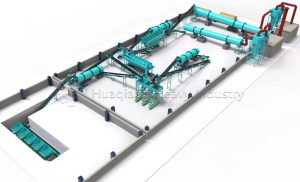Introduction
The bio-organic fertilizer production line is a key system for converting organic waste such as livestock and poultry manure, straw, and kitchen waste into high-efficiency fertilizer. Among them, the fertilizer granulator, as the core equipment, directly determines the particle shape, strength and utilization rate of the finished product.
Working Principle of Fertilizer Granulator
Fertilizer granulators primarily form powdered fertilizer into granules or columns through extrusion and rolling. Common fertilizer granulators include disc granulator and double roller press granulator. In the case of a common disc granulator, for example, the powdered material rolls on a rotating, tilted disc, gradually agglomerating into granules.
In the bio-organic fertilizer production line, the fertilizer granulator needs to work in coordination with the fertilizer crusher machine, fertilizer mixer machine, fertilizer dryer and other equipment to ensure the production efficiency of fertilizer granules in the entire bio-organic fertilizer production line.
Features of fertilizer granulator
In bio-organic fertilizer production line, different fertilizer granulators require different granulation processes. For example, disc granulator use a wet granulation process, resulting in beautifully designed fertilizer granules with controllable diameters. Double roller press granulator use a dry granulation process, producing uniform granules.
Fertilizer granulators can process a variety of raw materials, compacting powdered organic materials into uniform granules. This not only facilitates transportation and storage but also improves the fertilizer’s slow-release properties.
Fertilizer granulators offer advantages such as low energy consumption, long service life, and high pelletization rates.



